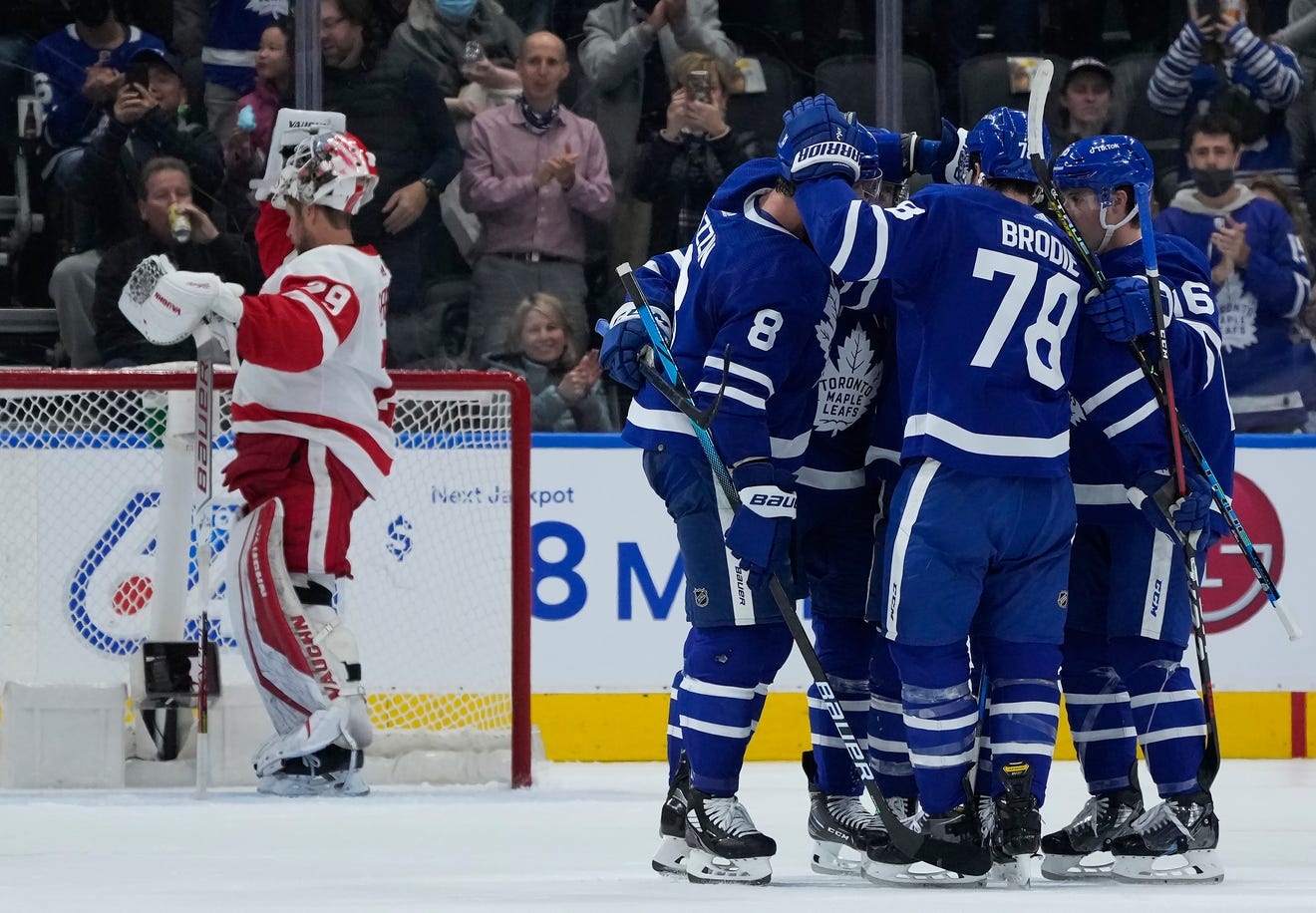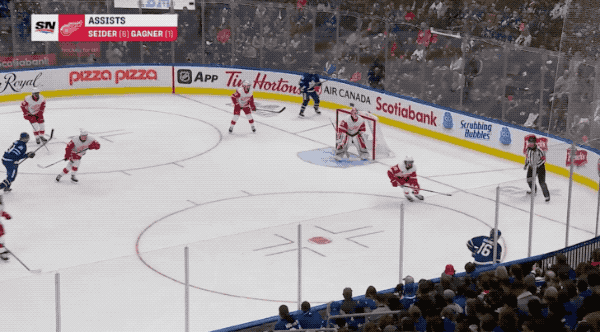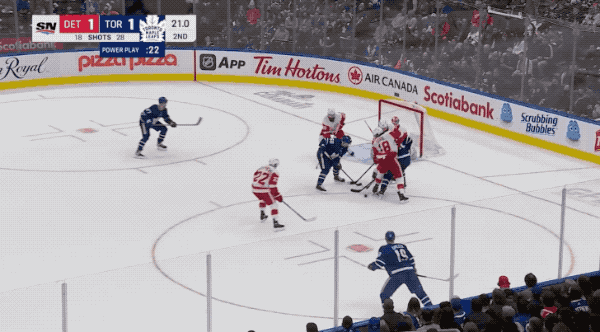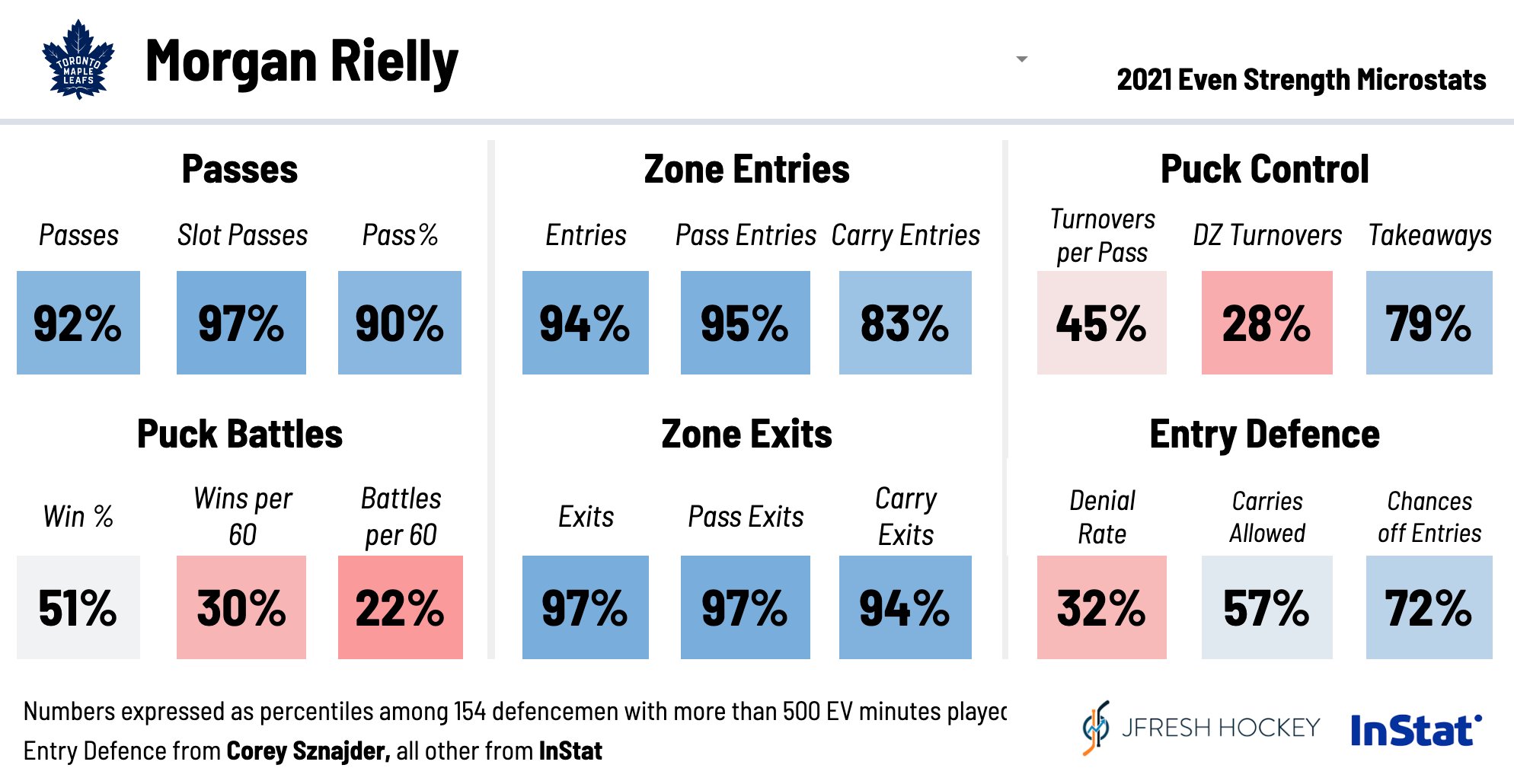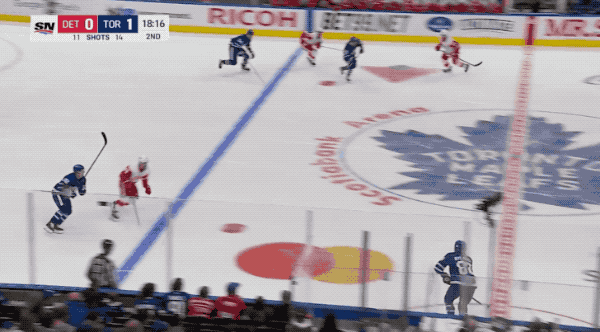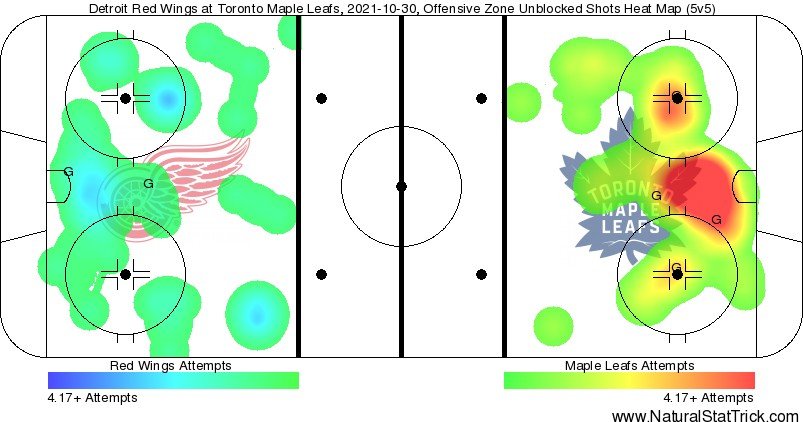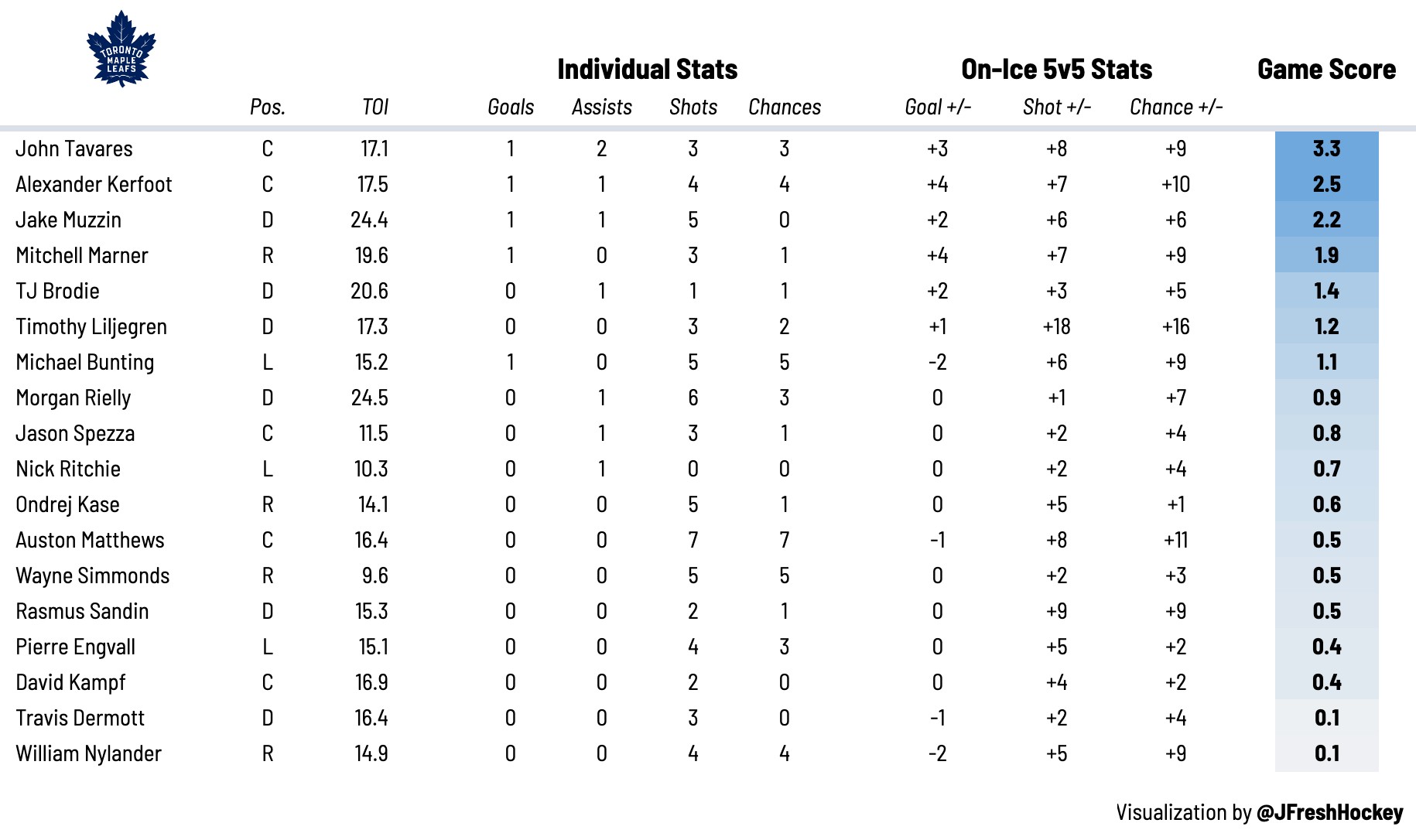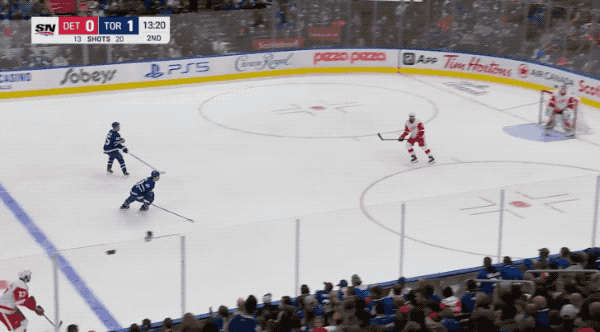They’re starting to look more like the Maple Leafs.
Let’s not plan the parade just yet after a couple of wins coming against the Chicago Blackhawks and Detroit Red Wings. With that said, the mood in Leafs Nation is much less dire coming off of back-to-back victories.
Personally, I’m not too obsessed with the final score when evaluating this team throughout the regular season. Hockey is a game of bounces, which is why I want to see the team I’m rooting for generate more shots and chances with consistency. Sometimes the pucks will go in, sometimes they won’t, but if you’re doing the right things to create offense and prevent the other team from doing so, good things will happen.
The pucks went in for Toronto tonight — five times, to be exact. Things got interesting towards the end, with Detroit closing the gap with a few late goals. The Leafs did end up hanging on for the 5-4 victory, and more importantly, largely dominated the run of play.
That’s what a 100-point projected team is supposed to do against a team that ranks third-worst in shot differential, but you can only play the teams ahead of you in the schedule. Enough cliches, I want to evaluate some hockey. It’s time for some Leafs Report Cards!
5 Stars
The Kerfoot-Tavares-Marner Line — This was the best game of the season for each player on this line, so let’s go through them one by one.
This is two games in a row where Mitch Marner looks like the confident, creative playmaker we all know can throw up a 95-point season. He had an extra jump in his step tonight and used that speed to make things happen off of the rush.
My favourite plays of his often come when he darts in at full speed and then pumps the breaks after gaining the zone to create the space for the next pass.
No assist for Mitch Marner on Toronto's first goal but that was a great entry. Great patience and skill to use every second possible to allow Tavares to get to space to receive a pass. pic.twitter.com/zhHwaLEGBm
— Mike Kelly (@MikeKellyNHL) October 31, 2021
For my money, Marner’s always been his most dangerous as a passer when he’s a little further away from the net. It’s part of the reason I’ve always loved the idea of trying him at the top of the power play as the defenseman.
The Leafs clearly still haven’t resolved their PP1 problems, so one outside-the-box idea is to move Marner to the top. They actually tried this for one game right before the pandemic hit, so it’s something to consider. I love how quickly he can make decisions with the puck, especially when he has the entire ice available to him from the point.
John Tavares also played a great game, throwing up a much-needed three-point night. His assist on the Alex Kerfoot goal was spectacular, somehow beating two Detroit defenders down low in a 1v2 situation and threading a pass right onto Kerfoot’s stick in the slot for the one-timer goal. Those two connected again on a 2-on-1 later in the game, with Kerfoot getting the puck across to Tavares, who buried the one-timer.
Kerfoot also hit the post off of a nice pass from Marner. It was by far his most impactful game offensively for the Leafs this season, which could also be said about his linemates. Even Marner picked up a somewhat lucky goal on a weird play, which goes to show that sometimes the On Ice Sh% gods will turn back in your favour.
The Sandin-Liljegren Pair — We can all agree that shots from the slot are generally a good thing, right? The Leafs had 17 of them when Timothy Liljegren was on the ice tonight and only allowed one. No amount of sheltered usage on the planet could inflate your numbers to that degree.
He earned those results by making great plays with the puck on his stick, especially in the offensive zone. He and Rasmus Sandin did an excellent job of using motion and quick passing to maintain possession for long stretches in the Red Wings’ end. Liljegren worked the high 3-on-2s really well in this game, interchanging roles with the high forward and connecting on a few quick passing sequences.
It may not seem like defense, but holding onto the puck with skill has its value. It’s the reason Sandin has only spent 40% of his time actually on defense this season. He also had a few great chances offensively by jumping into the play at the opportune time and delivering a pass to a dangerous spot on the ice.
It’s only one game for Liljegren, but Sandin’s consistently been tilting the ice every time he’s out there. Considering most of Toronto’s veteran defensemen have been on the wrong side of the ledger this season, it might be time to consider giving some of these talented young puck-movers a longer leash.
4 Stars
Jason Spezza (C, #19) — I feel bad watching Spezza try to start passing sequences with Nick Ritchie and Wayne Simmonds. It isn’t fair that one of the league leaders in slot passes is stuck alongside linemates who can’t make plays with the puck at 5v5.
On the bright side, Spezza has still looked fantastic in the 11 minutes he’s permitted to play each night.
He still has PP2 clicking at an elite rate while PP1 continues to have its struggles. The Leafs generate more shots, chances, and goals with Spezza on the ice at 5v4. We’re obviously dealing with tiny samples right now, but it’s enough for me to wonder if there’s a way to get Spezza onto PP1.
Pierre Engvall (LW, #47) — He made a couple of great plays tonight with his speed. The most memorable was his breakaway on the penalty kill, intercepting a pass through the middle with his long stick and then using those long legs to outrace the defender. He beat the goaltender high blocker but hit the post.
There was another great chance he manufactured out of nothing by gaining the zone in transition at 5v5 with his speed, going wide left on the entry, then taking the puck below the goal-line before making a pass out front to a teammate on the doorstep. Neither of these plays resulted in a goal, but they were each great chances created exclusively by Engvall.
3 Stars
Morgan Rielly (LD, #44) — Long-time readers will know I’ve been skeptical of Rielly’s value on the open market relative to the value he provides on the ice, particularly at 5v5. Even I can admit the $7.5 million cap hit on his recently signed eight-year extension is much less money than I expected him to get.
After diving into all of the numbers over the last 48 hours since he signed the contract, this is my favourite graphic I’ve seen that summarizes his playstyle.
It’s very possible that I’ve been underrating the offensive value he provides with his elite transition ability, moving the puck from DZ to OZ in a hurry and manufacturing rush chances out of nothing. His passing ability is also an aspect that really helps open up Toronto’s attack; they led the NHL in passes through the slot last season, according to Corey Sznajder’s manual tracking last season.
Rush chances and slot passes are two ways you can really boost your shooting percentage, especially when you’re making those plays alongside the Leafs’ top-six forwards. The issue is that a lot of those rush chances and slot passes come back the other way when Rielly is on the ice, which was very much the case tonight.
Much like Roman Josi, I really value his ability to play as a fourth forward when he’s on the ice, leading the rush in transition. That said, he needs to do a better job of preventing passes through the middle of the ice defensively. Rielly allowed a few of those tonight, one of which ended up in the back of the net.
If he’s going to be worth that $7.5 million cap hit, he needs to continue providing elite offense while playing defense that closely resembles what we saw in the playoffs from him.
They Were Fine
I like grouping players together sometimes when there isn’t too much to say about them after 60 minutes, so let’s do a rapid-fire round.
David Kampf (C, #64) — He very much is what he is as a player. You can expect him to play solid defensive hockey with his long stick disrupting plays when the opposition has the puck. You can also expect Kampf to make very few plays when he has the puck unless you consider a shot from distance a play.
Ondrej Kase (RW, #25) — Even though he terrifies me at least once per game with an awkward collision or two, Kase also makes a nice play or two offensively that remind you of his top-six upside. He had a dangerous-looking chance off the rush tonight, which hasn’t happened too often with him playing on the Czeching line alongside Kampf.
I’d like to see the Leafs try Kase beside Spezza for a few games to see what they could create offensively.
Michael Bunting (LW, #58) — He had a few nice hustle plays in tight off of rebounds, but in transition, plays were dying on his stick. I still love his ability to go hard to the dirty areas, although there’s an opportunity cost at some point to how many Matthews-Nylander rush chances you’re throwing away if Bunting fails to make the next pass.
Wayne Simmonds (RW, #24) — Similar to Bunting, I thought Simmonds was great at winning 50-50 pucks back by going hard into the boards every time. That’s what you want to see from your power forwards, fighting for the tough ice.
The Muzzin-Brodie Pair — With these two struggling mightily to start the year, Sheldon Keefe shook up the pairings and put both of Toronto’s veterans on a shutdown pair together. The results were a mixed bag, in my opinion.
Let me start by saying I know TJ Brodie had a primary assist on a Jake Muzzin goal. The pass was in Muzzin’s skates, by the way. Offensively, that was about it for these two aside from a nice stretch pass by Muzzin to get Marner a good chance off of the rush.
The bigger concern for these two is on defense.
They’re expected to be Toronto’s two shutdown options, with Brodie handling the defensive load so Rielly can play his natural position (fourth forward or “rover” if you will), while Muzzin handles tough matchups alongside whichever partner you throw his way — Nikita Zaitsev, Justin Holl, or heck, why not Timothy Liljegren?
The issue is that Muzzin and Brodie haven’t been pulling their weight defensively this year, giving up far too many scoring chances off of the rush. Muzzin is still getting beat in 1v1 situations, although it was nice to see him get a bit more physical when closing out hits along the blueline. Brodie got absolutely walked by Joe Veleno, which appeared to be a theme tonight.
The Leafs are going to continue to be a bad defensive team until their two best defensive defensemen start playing better defense. It sounds so simple, but it’s frighteningly true.
2 Stars
Petr Mrazek (G, #36) — This wasn’t the greatest start for Mrazek, but the good news is that he looked fine moving laterally in his crease after suffering a groin injury in Game 2 of the season. On Detroit’s second goal, I would have liked to see Mrazek get his stick out to prevent the pass out front. That’s something we’ve seen Jack Campbell do multiple times early in the season. As a goaltender, you can limit some of those chances with an active stick.
Travis Dermott (RD, #23) — Every time Dermott gets promoted into the top four, I get extremely excited because I’ve been in his corner for what feels like an entire lifetime. Then he goes out and plays that game and the results are underwhelming.
Tonight, his job was to be the defensive presence on a pairing with Rielly. It’s not the easiest task in the world, but if you can be the last man back and take away passes through the middle of the ice, you’ll get the job done. I thought Dermott was alright in that department tonight, but something felt off about his puck-moving.
Considering 2-on-1 slides are a specialty of Dermott’s, as is rush defense in general, the Rielly-Dermott experiment is one I’d want to get a longer look at. After 14 minutes together this evening at 5v5, I can’t say I’m confident enough in the sample to know exactly what we’re looking at here.
Nik Ritchie (LW, #20) — He was the only Toronto Maple Leaf tonight with zero shots directed towards the net, which is troublesome for a power forward who makes a living off of his ability to get to dangerous areas and get shots off from in tight.
It’s worth noting he’s been generating more chances per 60 minutes with the Leafs than he did last season with the Bruins — and he’s not going to keep shooting zero percent. The goals are going to come with Ritchie, but if we’re honestly assessing his play this season, it’s been bad so far.
1 Star
Matthews-Nylander — The easy part of this grade: William Nylander was terrible tonight. He made a couple of nice east-west passes in the offensive zone, but he also cost Toronto a goal against by getting walked right before the backdoor pass was made. His legs just weren’t in it tonight.
As frustrated as some of us get with a lethargic effort from Nylander, the more concerning trend to me is when he unnecessarily curls back off the rush.
He had Marc Staal (who is somehow still in the league) beat here, but instead of dropping his shoulder and driving to the net for a high-percentage chance, he avoids contact and settles for the lower percentage play. Tonight was a Bad Habit Nylander kind of night. He’s much more effective when he’s willing to get a bit more physical to earn his chances from closer to the net.
The hard part of this grade is the Auston Matthews portion. Dylan Larkin swallowed him up for the majority of their matchups defensively, with Matthews generating most of his chances against the Pius Suter and Michael Rasmussen lines. You’d like to see Matthews win his “matchup” in a game like this.
Then again, he did have a few brilliant rush chances from the right side of the ice, going with a backhand the first time around and then a couple of quick dekes to the middle to get a shot off from a better angle. Even on what felt like off-night for Matthews, he still generated seven shots from the slot.
It’s pretty incredible just how good this guy is at singlehandedly creating offense.
Heat Map
Here’s a quick look at where each team’s shots were coming from at even strength, courtesy of Natural Stat Trick.
The Leafs had 60 percent of the shots at 5v5 but had a whopping 72 percent of the scoring chances. As you can see in the heat map above, their shot quality was excellent tonight, generating most of their offense from the slot.
Game Score
Game score is a metric developed by The Athletic’s Dom Luszczyszyn to measure single-game performance. You can read more about it here.
It’s weird seeing Nylander at the bottom of one of these, which is a nice reminder that sometimes good players have off-nights.
Tweet of the Night
Two of my favourite hockey analysts, Justin Bourne and Mike Johnson, discussed Toronto’s defense right after the game. It’s been Toronto’s biggest weakness so far this season, so naturally, we all want to know why the team is struggling on that end of the ice.
Watching tonight's game, the D probably would have been fine defensively with a little more support from forwards.
— Mike Johnson (@mike_p_johnson) October 31, 2021
Mike Johnson brings up a really good point here. As much as I want to get frustrated with Muzzin and Brodie’s struggles defensively, particularly when defending the rush, it’s hard to step up on an opposing forward if you don’t have backpressure from your forwards.
Team defense is a collective concept and requires commitment from all five skaters on the ice, including the forwards. I’ve noticed a few times this season Toronto’s forwards tend to be behind the play in transition. Some of their skaters with slower foot speed have a tendency to get caught behind the play.
Keep an eye on how much pressure Toronto’s forwards are applying on the backcheck over the next couple of games. They could do a much better job to help make life easier on their veteran defensemen.























